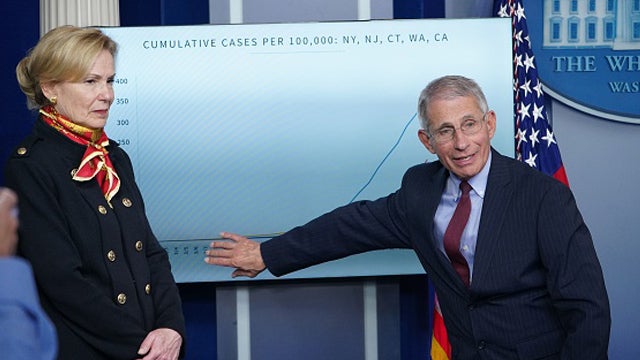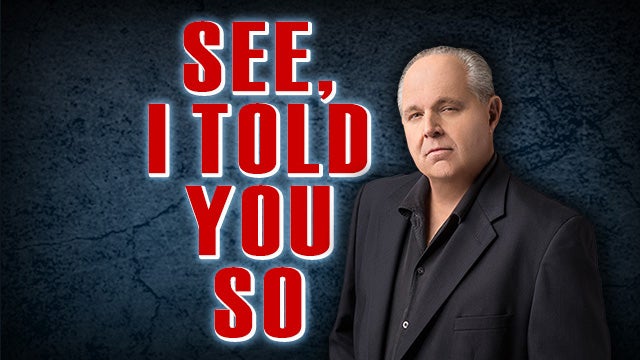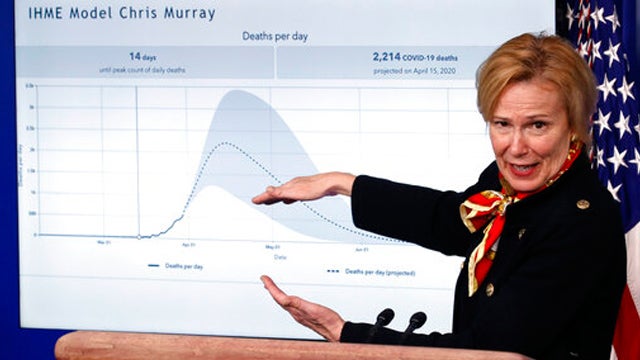RUSH: The media having a field day with this aspect of the briefing yesterday. TheHill.com: “White House Projects Grim Death Toll from Coronavirus — President Trump’s top health advisers said Tuesday that models show between 100,000 and 240,000 Americans could die from the novel coronavirus even if the country keeps stringent social distancing guidelines in place.

“Dr. Deborah Birx explained, ‘There’s no magic bullet. There’s no magic vaccine or therapy. It’s just behaviors.'”
Now, in the 12th paragraph of this story we find this. “Still, Birx and Fauci stressed that the total number of deaths is not certain to hit 100,000 if Americans strictly follow recommendations on social distancing. ‘We really believe and hope every day that we can do a lot better than that,’ Birx said.”
So, they’re putting these big numbers out there. And it’s kind of like in the early days of the Trump-Russia collusion, every day, five stories a day, New York Times, Washington Post: “Trump colluded with Russia, we have anonymous experts from the intelligence community who tell us that they’re working on it, providing evidence,” so forth. Twelve paragraphs in you get a little sentence saying: “To date no evidence has been forthcoming to show any collusion between Trump and Russia and the 2016 election.” The previous 15 paragraphs are totally irrelevant. It’s the same thing here. Twelve paragraphs in,
“Still, Birx and Fauci stress the total number of deaths is not certain to hit 100,000 if Americans strictly follow recommendations on social distancing.”
But, see, it doesn’t matter. The 240,000, it’s a new number, so that’s all the media heard, because they want to use that number along with Fauci saying that we can’t let up on restrictions that are killing the economy. Most of the media ignored Fauci’s more optimistic remarks, saying we hope we don’t even get to a hundred thousand. So they don’t have to happen. Hundred thousand deaths does not have to happen. And I’ve got a story here with different models for different states that show a wide variety of projected death tolls, and it illustrates that we’re really not dealing with a one-size-fits-all policy here, even though we are attempting to do just that.
In fact, I’ve got some audio sound bites of — let me go back. Grab audio sound bite number 1. I just want to remind you of the philosophy on the doomsayer. Doomsayers always win, folks. It’s a psychological aspect of life in America and practically everywhere. Doomsayers always win. The doomsayers cannot lose. It is the realists and the optimists like me who have our heads in the guillotine when we try to speak the truth. Here’s what I said on this program on Monday.

RUSH ARCHIVE: The doomsayers always win. Do you realize this? The doomsayers always win in a psychological sense. “What do you mean, Rush?” Well, let me explain it to you. I’m glad you asked. If it’s bad — if it is as bad as they say — they will say, “I warned you. I told you it was going to be 100,000 dead, 200,000 dead. I told you!” If it isn’t as bad as they say, if it doesn’t end up being as bad as they predict, they then say, “It’s only because we warned you to do what was necessary to avoid the threat.”
They are never wrong. The doomsayers are never wrong; they always win. They’ve got an answer for everything. The realists, like me… I’m the mayor of Realville. I am Mr. Literal. This program is Realville. I am the mayor, governor, president, whatever. I’m an optimist. I can’t help it. I have the optimist gene. We never win up against the doomsayers.
RUSH: Meaning that if I were to say, “Folks, I don’t believe the 240,000 figure. It’s gonna be less than that, da-da, I would immediately be attacked for disavowing the experts and misleading people and being irresponsible about it. And so trying — and this is what Trump’s trying to do. Trump has made it clear that he wants to give the country hope. That he’s not a pessimist either. He wants to give the country hope.
He wants to give the people a reason to think that we’re gonna come out of this and come out of this soon. I understand that, and I agree with it, ’cause I believe in self-fulfilling prophecies. You can doom-and-gloom yourself into negative paralysis. You can also talk yourself into optimistic outcomes and create them by virtue of your attitude and behavior. And that’s what Trump is trying to do. And I’m far more comfortable with that. But doing that in the face of all this would be cited as irresponsibility. Because who are you? You’re just a guy on the radio. You’re not an expert. You’re not a health expert. You don’t have access to the models.
Hey, that’s another thing. You know, we keep getting all this modeling data. Wouldn’t it be great if the people doing the models showed up at a briefing? Why do these people get to hide? I got nothing against them, don’t misunderstand. But as you know, I have a problem with modeling. ‘Cause they’re never right. They’re never right, even admitted this. So bring ’em up there. Let’s see the charts and graphs that they are using to produce the data that the experts and the health officials and the president are using to inform people during the briefing.
Now, also yesterday we focused a lot on California. Victor Davis Hanson had a piece at National Review Online yesterday. He said there’s 150 deaths — was it 150 deaths? The California population is 40 million. The number of people dead in California is an infinitesimally small percentage. And it’s really curious because California, 5,000 to 7,000 travelers a day arrive from China in December and January, particularly Chinese New Year. And they’re landing at San Francisco, landing in San Jose, they’re landing in San Jose. Landing in LAX.
And one of the things I was asking, is it possible that the state of California unknowingly had the coronavirus running through its state and population in December and January and they just dealt with it, people got it, didn’t know they had it because we didn’t know about coronavirus and at the time in December and January it was still something that was located in Wuhan, ChiCom.
So the subject came up yesterday, miraculously. Now, of course my name wasn’t mentioned, but, folks, that it doesn’t matter. I am always present at these things. Spent a long time talking about — magically somehow the subject of California came up because they do not have a massively upswinging curve on number of new cases, deaths, hospitalizations. State of Washington, ditto. Their curve is on the way down. And they had the early reporting of 22 deaths in one nursing home out there. So a legitimate question being asked. This came up yesterday at the briefing with Dr. Birx, and this is what she said about California and Washington state.

BIRX: We all remember Washington state. It was just a month ago when they started to have the issues in Washington state, but they brought together their communities and their health providers and they put in strong mitigation methods and testing and you can see what the result in Washington state and California is. But without the continuation for the next 30 days, anything could change.
RUSH: So they’re standing by the belief that social distancing and staying inside, staying home, not mingling, you know, no orgies and that kind of stuff, useless stuff that happens in that state is not happening and that’s why the cases in California, deaths in California are way down. They’re chalking it up to social distancing. No doubt. But can there not be some other explanation for this?
But look. Mitigation is it. That’s what they’re gonna stick with. That’s what they’re laying everything on the line here. Mitigation is the way we’re gonna deal with this. Whenever there is any success anywhere, they’re gonna chalk it up to mitigation, meaning social distancing and staying home and not mingling with people. Here’s the governor of California who was on CBS This Morning today with Anna Werner. His name is Gavin Newsom. Question: What does the data about California’s cases say to you?
NEWSOM: It’s too early for me to judge it, but the reality is the state was quick to move on social distancing. As a consequence, I think some of those early actions may prove fruitful. Time’s everything. Every hour, every minute of every hour, every day is a day we’re never going to get back. Every single day is the opportunity to save lives. And so that’s what we have bought here in California. And that’s what I’m currently focused on. Not the models, I want to prepare for the worst.
RUSH: Well, that’s what the models are. The models are the worst. But, anyway, so you see the credit here is all going to mitigation. And again, that word “mitigation” simply is a substitute for social distancing. Mitigation strategies. How do we mitigate the spread, how do we stop the spread. We don’t come in contact with each other. And that’s what they’re chalking up as the primary reason for the relative success compared to other places in California, state of Washington.
BREAK TRANSCRIPT
RUSH: This is Greg, South Williamsport, Pennsylvania. Thank you for waiting, sir. Hello.
CALLER: Hey. Thanks, Rush, for taking my call. Last night during the task force update, they were talking about models and all the numbers they had, the hundred to 240,000 deaths. What was interesting was Dr. Birx keeps referencing a University of Washington model that closely models theirs, and that actually has 40 to 160,000 deaths, not a hundred to 240,000. I’m wondering if maybe Fauci has been able to push his will on both Dr. Birx and the president on this, or maybe they’re not even sharing this information with the president.
RUSH: Try to be a little bit more clear. You think that Fauci is prevailing in presenting the worst-case scenario when the others don’t want to present the worst-case scenario?
CALLER: Yeah, that’s correct, because what was interesting was Dr. Birx had slides from the actual model that she keeps referencing —
RUSH: Yeah, she got beat up by the media when she presented some pretty good figures in her model. She had to do a 180 to keep the media off her back. That’s the way I interpreted it.
CALLER: Right. I’m just… It’s intriguing that they used that model to show everything that they were doing, plus going forward, and that future mitigation would push it down. But she almost… It’s almost like she’s not allowed to say what she wants to say.
RUSH: Well, now, that is interesting, and I’ve had a number of people can reach out to me with the same opinion about Dr. Birx. I’m getting it from all sides, by the way. I know people who know Dr. Birx and they’re telling me, “She’s the best thing that’s up there. She’s doing her best! You can trust what she’s saying,” blah, blah, blah. I have to defer to people who know her.
But let me take the occasion here of your call to talk about models, because one of the models that was cited by the White House task force to predict the impact of the coronavirus is the Chris Murray model from the University of Washington. Now, the Chris Murray model is the model that predicts April 14th as when the coronavirus will peak in the United States as a whole.
So if you are familiar, if you think you’ve heard that the peak date is April 14, that is because there is a model from a guy named Chris Murray, University of Washington, saying that. But all of these projections depend on strong social distancing being in play, meaning you staying at home and staying six to 10 feet away from people.
 What I have here is model projections for each state, not just peak national. “The United States…” It’s from Breitbart. “The United States as a whole is roughly two weeks away from reaching the peak of the coronavirus pandemic, but the peaks for individual states will vary with most occurring over the next four weeks, according to projections from the University of Washington’s Institute for Health Metrics and Evaluation.”
What I have here is model projections for each state, not just peak national. “The United States…” It’s from Breitbart. “The United States as a whole is roughly two weeks away from reaching the peak of the coronavirus pandemic, but the peaks for individual states will vary with most occurring over the next four weeks, according to projections from the University of Washington’s Institute for Health Metrics and Evaluation.”
That’s Chris Murray. Now, here are the projected peaks for some states. I’m not gonna go through all 50 here. That’d take me awhile. Vermont: April 9th. New York: April 9th. Louisiana: April 10th. Pennsylvania: April 15th. Washington, D.C.: April 18th. New Jersey: April 9th. Michigan: April 10th.
Connecticut: April 10th. Washington: April 24th. Maine: April 25th. Tennessee: April 26th. California: April 26th. Florida… The peak here in Florida is not supposed to hit until May 3rd. In Missouri, the peak will not be ’til May 11th. In Kentucky, May 12th. Virginia is may the 17th. Montana: April 30th. New Hampshire: April 30th. Georgia: April 22nd.
So it runs the gamut basically from April 9th to May 17th, but the nationwide peak is said to be April the 14th. But these projections are contingent on the continuation of strong social distancing measures, and we don’t have a vaccine. So when are they gonna let people loose, and what’s gonna happen when they let people loose again?
If they let people loose — and they’re gonna have to let people loose, because that’s gonna mean turning the economy back on. What’s gonna happen then? When is that gonna happen? The degree of uncertainty over all of this is… (interruption) Yeah, and Governor DeSantis has now reversed course. He has ordered residents to stay home in the state of Florida for I think, what, 30 days?
It’s 30 days, 30 days, and Congress… Congress is supposedly not gonna come back to Washington for at least a month. “California Schools Unlikely to Reopen This Academic Year.” So you see we are still trending in the — well, what I consider to be — unfortunate direction.
BREAK TRANSCRIPT
RUSH: Here’s Eric in Margate, New Jersey. Great to have you with us, sir. Hello.
CALLER: Hey, Rush. How you doing?
RUSH: Good.
CALLER: Great.
RUSH: Thank you.
CALLER: The reason I called, I was telling Bo: Listen, I don’t want people to take me wrong. I’m here in South Jersey. I’m 2-1/2 hours from New York City. I’m two hours, basically, from North Jersey. I got about 38 cases of corona in my county, and I was telling Bo. I said, “If I could go to Sam’s Club, BJ’s, Walmart, Target, Home Depot and my local grocery store and keep my distance, why do they gotta close up these other department stores then? Can’t we all go there and keep our distance there, too?”
RUSH: Well, because people have to work closely together if the store is open, and it’s harder to maintain the six-feet social distancing if there’s hustle and bustle of retail crowds. That’s the thinking, I guess.
CALLER: Like in the Depots, they’re letting 50 people at a time in Home Depot, and there’s a line outside and a friend of mine was complaining about how close they were in line.
RUSH: Fifty people in at a time at the Home Depot? Before all this, you mean?
CALLER: No, this is what’s presently going on now.
RUSH: Oh, they’re letting 50 people at a time in?
CALLER: Yes. But you have to wait outside in line to, you know, go in. But a good friend of mine says, “The people, they’re all close together waiting in line talking to each other.” So my whole point is aren’t these department stores, too, though? So can’t we maybe open up some of the other department stores and keep our distance?
RUSH: Well, let me tell you something. As I understand it — and I don’t pretend to. (chuckles) But as I understand it to explain it, there is a one-size-fits-all policy that has been devised as the simplest and fairest way of implementing it, that if you… Like you say, if you let the people in Margate, New Jersey, go to retail stores, but they can’t in New York City?
“It’s not fair!”
And you’re gonna have people leave New York City to come to Margate to go to store, defeating the purpose. People are not gonna stay where they are if what they want is only a couple hours away. They’re gonna flood the market. We know this. This is what I’m told is why they have to have a one-size-fits-all policy. Plus, the one-size-fits-all is the supposed epitome of fairness as well. I understand your point. I hope my answer is sufficient.


